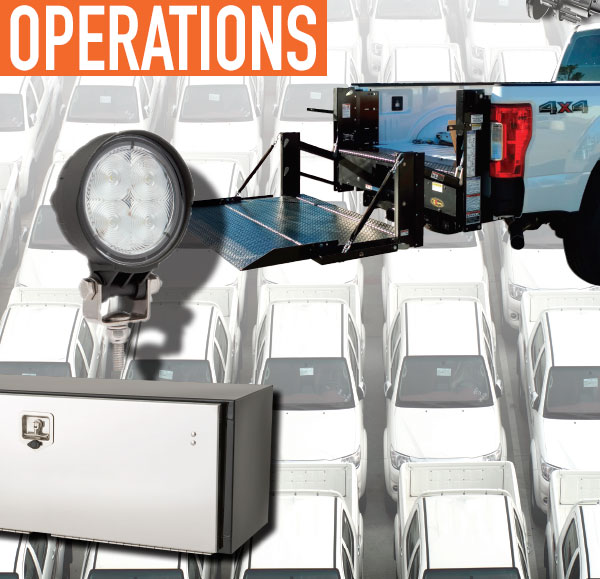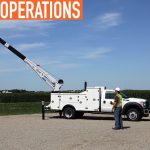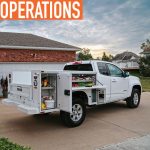In our previous two articles, we covered the functional levels of the work truck industry supply chain; OEMs, body manufacturers, distributors, and dealers, revealing the fragmentation that makes it difficult to track final configurations of work trucks and vans. We then illustrated how the lack of that data in the work truck industry affects your business, by taking significant time to get a work truck built, as well as the challenge in communicating the benefits of existing configurations.
There are 1,900 companies that manufacture, distribute, install, sell, and repair commercial trucks, truck bodies, truck equipment, trailers, and accessories. With so many companies involved in finishing work trucks, there are only a couple ways that the existing industry fragmentation causing delays in the supply chain can be improved upon; first by reducing the number of players in the industry, and second by improving the technology in the industry. This article will focus on the organic changes that are taking place in the industry as it is dragged kicking and screaming into the 21st century.
PARTNERSHIPS
Since the forecast for US economic growth in 2017 is only slightly more positive than 2016 (a 2.2% growth projected), an increase in the number of players in the industry is unlikely, especially considering the capital intensive barrier to entry for manufacturing. The labor market is tight, which makes it difficult for companies to make more products without more labor, resulting in wage increases as companies try to attract new employees from other companies. These two conditions are leading to more partnerships and to mergers—geographic extension mergers (where the buyer makes the same product as the target firm in a different geographic market) and product extension mergers (where a firm buys a firm that makes a different product that requires the application of similar manufacturing or marketing techniques).
Examples of partnerships include a strategic partnership between Sortimo International, a global leader in mobile racking products, and The Knapheide Manufacturing to better serve both their van customers and customers that need compartment solutions. The benefit for you is that you only deal with one producer (Knapheide) rather than two.
Another partnership example is Truck Accessories Group (TAG), which is comprised of seven companies: LEER, Snugtop, Pace Edwards, Century, Raider, StateWide Windows, and Waypoint Logistics, where they have combined the strengths of its LEER Fleet, SnugTop, and Pace Edwards brands to deliver the fleet industry’s broadest line of caps, tonneaus, and retractable covers, available from a single source.
Recent mergers include Reading Body Company’s acquisition of CASECO, both a geographic and a product extension merger, which adds the Master Mechanics brand, as well as additional distribution and ship-through locations. In addition, Reading has made an acquisition of the service body division of Palfinger, again adding both geographic locations and product. Another example is the acquisition of Randall manufacturing, Rear View Safety, and Fleetmind, all product extensions by Safe Fleet. These examples of mergers are just a few that are happening in the work truck industry.
NEGOTIATING EFFICIENCY
Partnerships and mergers are picking up due to the stable, albeit not rapidly growing, state of the industry. This trend ultimately could help make the process of building work trucks and vans more efficient, but this is a slow process. Even after the acquired company is integrated into the parent, or the partnership is inked, the resulting new firm or operation must still address old methodologies and lack of technology. That really is the key issue for the entire work truck industry.
In our previous article, we mentioned that one manufacturer has more than 15,000 configurations on the books. Not only is it critical for the company to consolidate (its goal is 1,500) for purposes of efficient and cost effective manufacturing, but also to be able to communicate to you, the buyer, the configuration (model) and the specific benefits for your job. Best practices/uses must become a focus to drive efficiencies for you (the buyer) as well. Using the 80/20 rule is just the start; identifying the best configurations by vocation—that is the Holy Grail.
LIMITED TECHNOLOGY
After visiting numerous manufacturing and distributing operations, one interesting issue appears over and over: The work truck industry is bereft of technology. Internally, there is none of the standardization needed to build databases.
Let’s look at an example: The internal name for an eight-ft service body consists of a number and letter combination; the name of the same body in nine ft is not sequential because the nine-ft body was added to the product line ten years later. Also, there is no standard code for adding a third or fourth drawer, instead it is written in a notes section of the order form. Because the internal names look completely different, employees must memorize the names to differentiate them and order them properly, as long as they can understand exactly what the customer wants. However, the marketing brochure calls the service body a name that represents strength and durability, but does not tie back in any way to the internal alphanumeric labels. How does a company start to standardize a system built over decades, with no true schema designed to be used for tracking in a database? And, fix all this while running a business.

This is why even the largest manufacturers have limited adoption of technology outside of their manufacturing processes. There are no “niche” ERPs for this industry. The OEM pools (see previous article), the manufacturers, and their distributors are not connected digitally in any bi-directional fashion, so there ends up being a lot of paper on clipboards and many spreadsheets by email.
INVENTORY MONITORING
Imagine a world where checking on-hand stock consists of needing to:
- Find the email with the last excel list of vehicles (possibly weeks old), scroll through looking for the right section, distributor, location, VIN
- Walk out to the yard and physically count trucks, vans, and bodies
- Get in the car and drive to the dealership that purchased their dump body, service body, contractor’s body, etc. with a clipboard and manually check off the list if they are still on the lot.
Sound tough? It is.
Now you have the entire picture of the supply chain; how your work trucks are built and by whom, how they are delivered, and what adds delay and confusion. The next, and final article, will focus on the future of the industry—what is happening in the industry and how technology must and will be adopted to improve everyone’s lives.
ABOUT THE AUTHOR
Kathryn Schifferle is the founder and CEO of Work Truck Solutions. Find out more about Work Truck Solutions and its services, visit www.worktrucksolutions.com.
_______________________________________________________________________
MODERN WORKTRUCK SOLUTIONS: MARCH 2017 ISSUE
Did you enjoy this article?
Subscribe to the FREE Digital Edition of Modern WorkTruck Solutions magazine.
![]()




